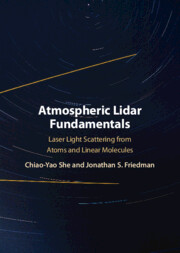Book contents
- Atmospheric Lidar Fundamentals
- Atmospheric Lidar Fundamentals
- Copyright page
- Dedication
- Contents
- Foreword
- Preface
- 1 Introduction
- 2 Classical Light Scattering Theory
- 3 Semiclassical Treatment of Light Absorption and Scattering from Atoms
- 4 Rayleigh and Raman Scattering from Linear Molecules
- 5 Introduction to Lidar Remote Sensing and the Lidar Equation
- 6 Common (Broadband) Lidar Types and Associated Applications
- 7 Lidars for Profiling Aerosol Optical Properties, Atmospheric Temperature and Wind
- 8 Transmitting and Receiving Optics
- Book part
- Index
- References
4 - Rayleigh and Raman Scattering from Linear Molecules
Published online by Cambridge University Press: 24 February 2022
- Atmospheric Lidar Fundamentals
- Atmospheric Lidar Fundamentals
- Copyright page
- Dedication
- Contents
- Foreword
- Preface
- 1 Introduction
- 2 Classical Light Scattering Theory
- 3 Semiclassical Treatment of Light Absorption and Scattering from Atoms
- 4 Rayleigh and Raman Scattering from Linear Molecules
- 5 Introduction to Lidar Remote Sensing and the Lidar Equation
- 6 Common (Broadband) Lidar Types and Associated Applications
- 7 Lidars for Profiling Aerosol Optical Properties, Atmospheric Temperature and Wind
- 8 Transmitting and Receiving Optics
- Book part
- Index
- References
Summary
In Chapter 4, we look at nonresonant scattering, specifically Rayleigh and Raman scattering from linear molecules. We continue with the semiclassical (quantum) treatment, leading to the induced dipole moment and associated differential scattering cross section. Explicitly adding vibrational and rotational manifolds of the ground state, we show the results for all three regimes: Rayleigh, rotational Raman, and vibrational Raman scattering. We then apply these results to nitrogen and oxygen molecules and associate the results with macroscopic quantities, such as the index of refraction of an ensemble, or gas. From this point, we focus specifically on Rayleigh + vibrational Raman spectra of O2 and N2, determining vibrational and rotational constants and the thermal populations of the states, based on their molecular energies, which leads to the spectral strengths of individual lines. We finish this chapter with a description of the Cabannes spectrum and the effect of the density fluctuations on its lineshape, considering the success of theoretical models in reproducing these spectra in Knudson (low-density), kinetic (medium-density) and hydrodynamic (high-density) regimes.
Keywords
Information
- Type
- Chapter
- Information
- Atmospheric Lidar FundamentalsLaser Light Scattering from Atoms and Linear Molecules, pp. 50 - 93Publisher: Cambridge University PressPrint publication year: 2022
